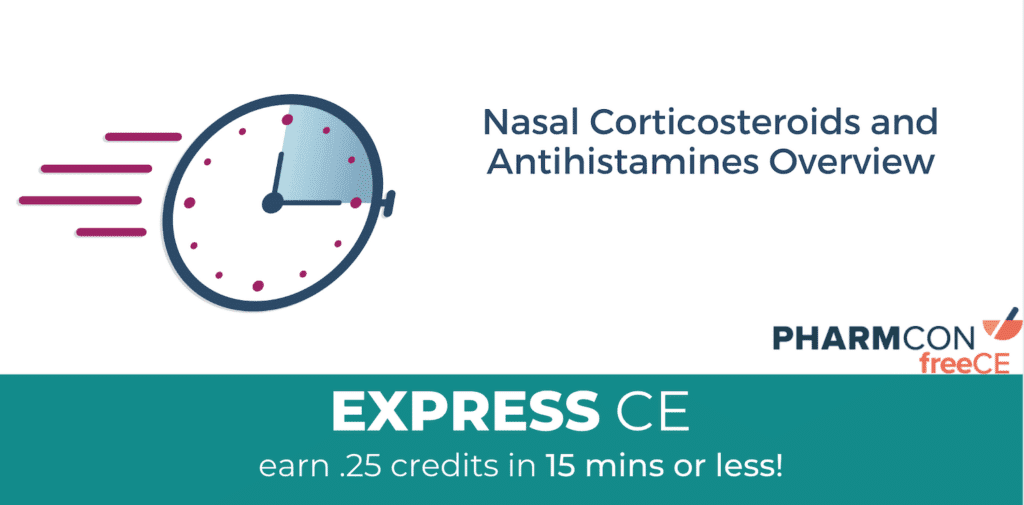Neti pots were the rage a few years back. We could not keep them on the shelves! I can’t imagine using something that gives me the sensation of waterboarding.
Like every other pharmacy, we dispense boatloads of fluticasone from the prescription department. I make sure my patients know exactly how to use this product. I stress to them that it should be used every day, especially during the high pollen season, as we are here in the Northeast.
I tell patients to give it at least 5-7 days to see any benefit. I tell them that when you rub a steroid cream on a rash it doesn’t immediately vanish, but it takes several days to clear out the inflammation.
The newer formulations that are alcohol and scent free are kinder and gentler to the nose that previous formulations such as original Flonase®. Remember Decadron turbinaire®, Vancenase® and Beconase®? Those were harsh as well and were likely to cause nosebleeds.
Table of Contents
Nasal Corticosteroids
Topical nasal corticoids have emerged as the MOST effective treatment for allergic rhinitis. Glucocorticoid nasal sprays are more effective than oral antihistamines for relief of total nasal symptoms, including blockage, sneezing, discharge, itch and postnasal drip. Currently five are available without prescription. Although these drugs are extremely effective, and now very inexpensive, proper administration technique is necessary for optimal results. That is why pharmacist consultation is necessary to achieve patient satisfaction and symptom relief.
*Note: For nasal corticosteroids, efficacy is limited if used as needed. These products should be used every day to maximize the effectiveness.
- Mechanism
- inhibits the activity of multiple cell types, such as mast cells, basophils, eosinophils, neutrophils, macrophages, lymphocytes, and mediators of the inflammatory response. Decreases capillary leakage and mucosal secretions.
- Indications
- management of nasal symptoms of seasonal and perennial allergic and non-allergic rhinitis.
- relief of pruritus, sneezing, congestion, rhinorrhea.
- Warnings/Precautions/Adverse Effects
- This medication may cause stinging, dryness, irritation, nosebleeds, sore throat and burning. Additionally, patients can experience alterations in taste.
- While some inhaled corticosteroids may cause local infections with Candida, this has very rarely occurred with the intranasal products.
- This product also contains a warning that it may slow the growth rate of children. Therefore, it should only be used for the shortest amount of time necessary to achieve symptom relief.
- Adult supervision is required to use these products if the patient is under 12 years of age.
- Patient Counseling
- Advise patient that even though they may experience relief in 2 or 3 days, continue to use the medication as peak response takes 2-3 weeks. This drug is not to be used “as needed,” rather it should be used for the entirety of the allergy season.
- Patient technique is essential to ensuring the patient is getting the correct dose. Advise them to use the following steps:
- Blow nose
- Remove the cap of the nasal spray.
- Prime bottle (if the medication has never been used before)
- Shake the nasal spray device.
- Tilt head forward and exhale (“It goes in your nose, look at your toes”)
- Complete a direct spray toward the ear on the same side. (Use the left hand to spray the right nostril, and the right hand for the left nostril)
- Place the pump into one nostril. Close the other nostril with a finger.
- Administer a spray into the nostril while inhaling slowly and deeply.
- Do not sneeze or blow the nose for 10-15 minutes after the spray administered.
Triamcinolone (Nasacort® Allergy 24 Hours)
This medication was first approved in 1957 as a prescription medication and then approved again in the Fall of 2013 for OTC use. This nasal spray is both alcohol and taste free.
- Adults and children 12 years of age and older: Two sprays each nostril while sniffing- once daily. Once symptoms improve, they may decrease to one spray in each nostril.
- Children age 6-12: One spray each nostril. They may increase only if needed.
- Children age 2-6: One spray each nostril daily.
- Do not use in children under age 2.
Fluticasone (Flonase®)
Flonase® was first available as a prescription in 1994. It was later approved for OTC use in the Summer of 2014 for relief of itchy/watery eyes and nasal symptoms. It is important to note that the liquid vehicle of OTC fluticasone propionate contains phenylethyl alcohol which has an odor like perfume. Perfume apprentices have described this alcohol scent as “rose note; very lasting/mild and warm rose honey.”
- Adults and children 12 years of age and older: Two sprays each nostril while sniffing- once daily. Once symptoms improve, they may decrease to one spray in each nostril.
- Children age 4-11: One spray in each nostril.
- Do NOT use in children under age 4.
Fluticasone furoate (Flonase® Sensimist)
This mist formulation of fluticasone is both alcohol free and scent free.
- Children 12 years of age and older:
- Week 1—use two sprays in each nostril once daily.
- Week 2 through 6 months—use one or two sprays in each nostril once daily, as needed.
- Children age 2 – 11: one spray per nostril each day, for a maximum of two months of use per year.
Budesonide (Rhinocort® AQ)
This prescription medication underwent a switch to OTC status which was approved March 2015. This formulation is both scent and alcohol free.
- Children age 12 and older: two sprays in each nostril once daily
- Children age 6-12: one spray in each nostril once daily
This prescription medication underwent a switch to OTC status as well which was approved in March 2022. This formulation is both scent and alcohol free.
- Adults and children 12 years of age or older: two sprays in each nostril once a day.
- Children age 2-11: one spray in each nostril once a day.
Nasal Antihistamines
Azelastine hydrochloride 0.15% (Astepro® Allergy and Children’s Astepro® Allergy)
This medication was approved in June 2021 for OTC use to temporarily relieve symptoms caused by hay fever or other upper respiratory allergies (nasal congestion, runny nose, sneezing, itchy nose). This product contains the same ingredient and dose as the prescription Astepro® (azelastine 205.5mcg spray), which was approved back in 2009.
Azelastine is known to have a bitter taste, therefore both formulations of Astepro® include a taste-masking agents sucralose and sorbitol. In clinical trials, 94% of patients receiving Astepro® reported no bitter taste. It is important to mention that this medication may cause drowsiness.
Additionally, the over-the-counter option is promoted to work in 30 minutes and contain no steroids. It does not carry the pediatric growth suppression warning as a result.
- Adults and children 12 years and older: = once daily (two sprays in each nostril once daily) OR twice daily (one or two sprays in each nostril every 12 hours). Max = 4 sprays.
- Children age 6 to 11: one spray in each nostril every 12 hours
- Children under age 6: Do not use.
Cromolyn (Nasalcrom®)
This drug is categorized as a mast cell stabilizer. Mast cells are responsible for the release of histamine and various other inflammatory substances. The dose is one to two sprays three to four times daily for ages 2 and up. There are minimal adverse effects associated with this medication, however, it is less effective than glucocorticoid nasal sprays like fluticasone.
When it comes to administration, cromolyn follows different guidelines depending on the type of exposure. For brief exposures, such as being around cats, it is recommended to use the medication approximately 30 minutes before the exposure. The efficacy of cromolyn in such cases can be observed within minutes and may last for a few hours. However, for prolonged exposures like seasonal allergies, it is advised to start using cromolyn four to seven days before the anticipated exposure. It is particularly beneficial to begin the treatment before the start of the pollen season to effectively manage symptoms.
COMBINATION PRODUCTS:
- Dymista® contains azelastine and fluticasone in a nasal spray for ages 6 and older. Dose is one spray in each nostril twice daily.
- Ryaltris® contains olopatadine and mometasone for ages 12 and older. Dose is two sprays in each nostril twice a day.
Intranasal Saline
Saline formulated for the nasal cavity consists of sodium chloride 0.65% in purified water (USP), made isotonic with sodium phosphate/sodium hydroxide, with phenylcarbinol and benzalkonium chloride as preservatives. This buffering makes using saline more comfortable, and less likely to cause stinging. Saline is indicated for the relief of dry, irritated nasal passages due to colds, allergies, dry air, pollution, smoke, air travel, as well as use of decongestant or steroidal sprays. Patients using saline irrigation tend to show faster resolution of symptoms, less frequent reappearance of rhinitis, and reduced use antihistamines/decongestants. Additionally saline can be used on an as needed basis and has no side effect profile.
- Neti Pots
- Advise patients to keep their neti pots and irrigation bottles clean to reduce contamination after every use. Do not share! If patients who irrigate get frequent nasal infections, review their cleaning methods, or suggest a trial off irrigation.
- Limit nasal irrigation to once or twice daily. More frequently can be overly drying and irritating.
- Saline packets: There is no difference between isotonic (0.9%) or hypertonic saline solutions. The range of concentrations of hypertonic saline used in the various studies ranged from 2% to 3.5%.
- Some tap water may contain low levels of organisms, such as bacteria and protozoa, including amoebas, which may be safe to swallow because stomach acid kills them. But these “bugs” can stay alive in nasal passages and cause potentially serious infections, according to the Centers for Disease Control and Prevention (CDC). Use distilled water or boiled and cooled tap water.
- Naegleria fowleri: Improper use of neti pots may have caused two deaths in 2011 in Louisiana. The Centers for Disease Control and Prevention has tallied 157 primary amebic meningoencephalitis (PAM) infections in the U.S. between 1962 and 2022, with only four known survivors. A fifth, a Florida teenager, has been fighting for his life since last summer according to an online fundraiser by his family.
Have a great day on the bench!!
References
- Centers for Disease Control and Prevention. (n.d.). Naegleria fowleri and Amebic Encephalitis: Personal Protective Measures for Individuals Performing Ritual Nasal Rinsing. Retrieved from https://www.cdc.gov/parasites/naegleria/ritual-ablution.html
- Lexi-Comp. (2023). Triamcinolone (Nasal). Retrieved from https://online.lexi.com/lco/action/doc/retrieve/docid/patch_f/1802823?cesid=08k6HzovcWT&searchUrl=%2Flco%2Faction%2Fsearch%3Fq%3Dtriamcinolone%26t%3Dname%26acs%3Dtrue%26acq%3Dtriamcinolone
- Lexi-Comp. (2023). Fluticasone (Nasal). Retrieved from https://online.lexi.com/lco/action/doc/retrieve/docid/patch_f/340?cesid=0ijrlT0u38a&searchUrl=%2Flco%2Faction%2Fsearch%3Fq%3Dfluticasone%26t%3Dname%26acs%3Dfalse%26acq%3Dfluticasone
- Lexi-Comp. (2023). Budesonide (Nasal). Retrieved from https://online.lexi.com/lco/action/doc/retrieve/docid/patch_f/1770141?cesid=6pGkDjU5Dlu&searchUrl=%2Flco%2Faction%2Fsearch%3Fq%3Dbudesonide%26t%3Dname%26acs%3Dtrue%26acq%3Dbudesonide
- Lexi-Comp. (2023). Mometasone Furoate (Nasal). Retrieved from https://online.lexi.com/lco/action/doc/retrieve/docid/essential_ashp/410055?cesid=7BpbCyHlvaR&searchUrl=%2Flco%2Faction%2Fsearch%3Fq%3Dmometasone%2Bfuroate%26t%3Dname%26acs%3Dtrue%26acq%3Dmometa
- Lexi-Comp. (2023). Azelastine Hydrochloride (Nasal). Retrieved from https://online.lexi.com/lco/action/doc/retrieve/docid/patch_f/1768342?cesid=0c4qo5yv5HP&searchUrl=%2Flco%2Faction%2Fsearch%3Fq%3Dazelastine%2Bhydrochloride%26t%3Dname%26acs%3Dtrue%26acq%3Dazelastine%2Bhydrochloride
- Lexi-Comp. (2023). Cromolyn (Ophthalmic). Retrieved from https://online.lexi.com/lco/action/doc/retrieve/docid/patch_f/1772083?cesid=27uq8YtGzzr&searchUrl=%2Flco%2Faction%2Fsearch%3Fq%3Dcromolyn%26t%3Dname%26acs%3Dfalse%26acq%3Dcromolyn






